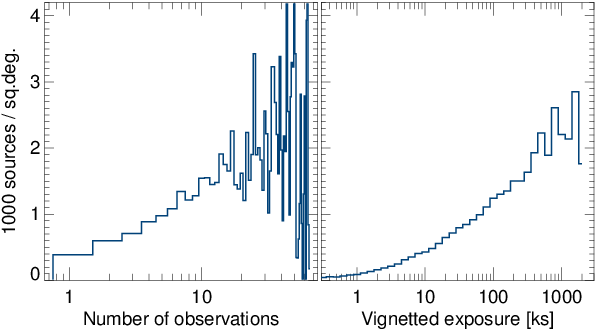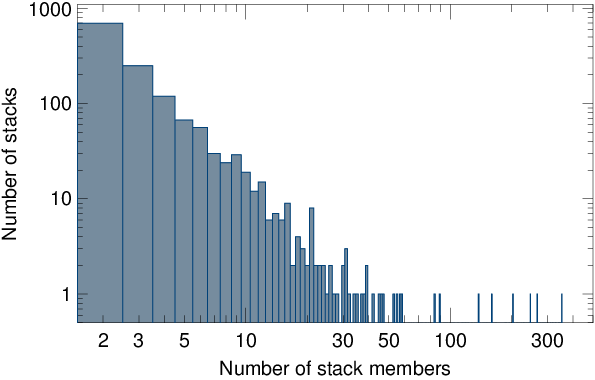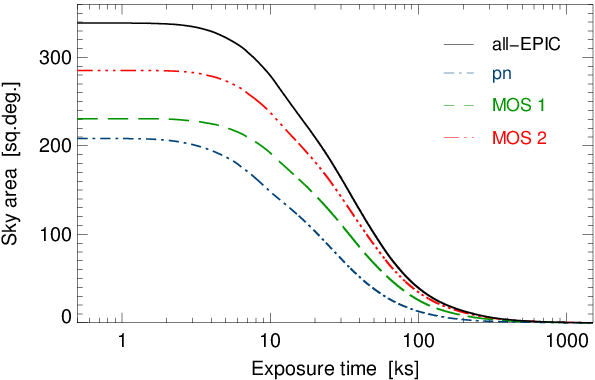Catalogue construction
 Source density in 4XMM-DR10s. Only small sky areas are covered by more than 30 observations or for more than 0.5Ms, causing the wider scatter in the plotted distributions.
Source density in 4XMM-DR10s. Only small sky areas are covered by more than 30 observations or for more than 0.5Ms, causing the wider scatter in the plotted distributions.
Determining persistently high background
Observations with high particle-induced background need to be identified before performing source detection for the stacked catalogue since their low signal-to-noise typically lowers the overall detection likelihoods of sources in the field and causes loss of sources. The optimised flare filtering of the 3XMM catalogues efficiently excludes intervals of high flaring background which are shorter than the total exposure time, but performs less well if it comes to images with high background throughout the observation time. In the 3XMM catalogues, these observations and the detections taken from them have been marked by a HIGH_BACKGROUND flag after source detection. From the stacked catalogues, they are excluded beforehand, in order not to contaminate good observations.
They are identified via a new standardised approach based on mean background count rates per unit area in the broad 0.2–12.0 keV band. From the bulk of 4XMM-DR9 observations, a distribution of background rates is derived for each instrument, observing mode, and filter. Fits to the distribution are used to define rate cuts. Details on the method can be found in the catalogue paper. Exposures with background rates above the limit were not used for the stacked catalogue (see next Section).
Field selection for the catalogue
The catalogue of sources in overlapping observations is based on data used to compile the XMM catalogues from individual EPIC observations and their selection criteria: Observations enter the catalogues, if they have a minimum net exposure time of 1 ks, which is the sum of good-time intervals after filtering the event lists, and non-empty images in all five energy bands. This first release of a stacked catalogue comprised selected good-quality observations. In the following releases, almost all overlapping observations are used:
- Observations are included if they overlap by at least 1 arcminute in radius,
- exposures by an instrument are included if the mean background level of each CCD (pn: chip quadrant) lies below the defined thresholds,
- EPIC/pn exposures in small-window mode are excluded because of their small area,
- the central CCDs of EPIC/MOS exposures in small-window mode are excluded, while the outer CCDs are included.
The final 4XMM-DR11s sample includes 8 292 observations in 1 475 stacks, the majority of them having two or three members.
 Number of observations in the 4XMM-DR10s stacks.
Number of observations in the 4XMM-DR10s stacks.
 Cumulative sky area of multiply observed 4XMM-DR10s regions over cumulated exposure.
Cumulative sky area of multiply observed 4XMM-DR10s regions over cumulated exposure.
Event-based astrometric correction
XMM-Newton source coordinates include a generally small systematic error arising from small offsets between the nominal telescope pointing and the actual boresight. In the catalogues from individual observations, they are reduced by comparing the X-ray with optical and infrared source positions in the SDSS, USNO-B1.0, and 2MASS catalogues. Field shifts in RA and Dec and field rotation are derived for each observation after performing source detection.
When several overlapping observations are processed, which have their individual offsets, corrections have to be applied before source detection. An event-based astrometric field correction was thus introduced with 4XMM-DR9s. During pre-processing, the recorded events are shifted to corrected positions. The corrections are taken from the results of the 4XMM-DR9 field rectification. The images on which stacked source detection is performed are created from the corrected attitude files and event lists, resulting in higher positional accuracy of the fit (cf. Traulsen et al. 2020). For individual observations that could not be corrected – e.g. because of a lack of optical and infrared counterparts –, a mean systematic uncertainty of about 1.3" remains (cf. Webb et al. 2020).

